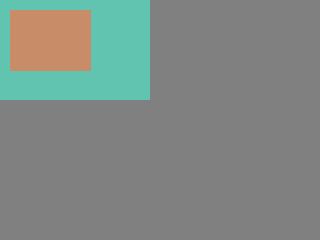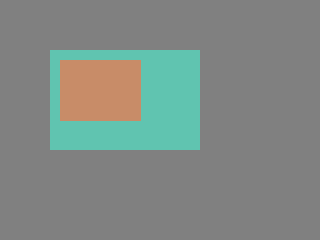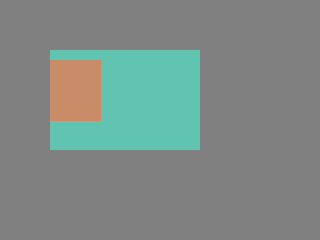Objects(对象)¶
查看原文
In LVGL the basic building blocks of a user interface are the objects, also called Widgets. For example a Button, Label, Image, List, Chart or Text area.
You can see all the Object types here.
All objects are referenced using an lv_obj_t pointer as a handle. This pointer can later be used to set or get the attributes of the object.
在 LVGL 中,用户界面的基本构建块是对象,也称为 Widgets。 例如 Button、Label、Image、List , 图表 或 文本区域。
您可以在此处查看所有 对象类型。
所有对象都使用 lv_obj_t 指针作为句柄进行引用。此指针稍后可用于设置或获取对象的属性。
Attributes(属性)¶
Basic attributes(基本属性)¶
查看原文
All object types share some basic attributes:
Position
Size
Parent
Styles
Event handlers
Etc
You can set/get these attributes with lv_obj_set_... and lv_obj_get_... functions. For example:
所有对象类型共享一些基本属性:
位置
尺寸
家长
样式
事件处理程序
等等
您可以使用 lv_obj_set_... 和 lv_obj_get_... 函数设置/获取这些属性。例如:
/*Set basic object attributes*/
lv_obj_set_size(btn1, 100, 50); /*Set a button's size*/
lv_obj_set_pos(btn1, 20,30); /*Set a button's position*/
查看原文
To see all the available functions visit the Base object's documentation.
要查看所有可用函数,请访问 Base object's documentation。
Specific attributes(特定属性)¶
查看原文
The object types have special attributes too. For example, a slider has
Minimum and maximum values
Current value
For these special attributes, every object type may have unique API functions. For example for a slider:
对象类型也有特殊的属性。例如,一个滑块有
最小值和最大值
当前值
对于这些特殊的属性,每个对象类型都可能有唯一的 API 函数。例如对于滑块:
/*Set slider specific attributes*/
lv_slider_set_range(slider1, 0, 100); /*Set the min. and max. values*/
lv_slider_set_value(slider1, 40, LV_ANIM_ON); /*Set the current value (position)*/
查看原文
The API of the widgets is described in their Documentation but you can also check the respective header files (e.g. widgets/lv_slider.h)
小部件的 API 在它们的 文档 中有描述,但您也可以检查相应的头文件(例如 widgets/lv_slider.h)
Working mechanisms(工作机制)¶
Parent-child structure(父子结构)¶
查看原文
A parent object can be considered as the container of its children. Every object has exactly one parent object (except screens), but a parent can have any number of children. There is no limitation for the type of the parent but, there are typical parent (e.g. button) and typical child (e.g. label) objects.
父对象可以被视为其子对象的容器。每个对象只有一个父对象(屏幕除外),但一个父对象可以有任意数量的子对象。 父对象的类型没有限制,但是有典型的父对象(例如按钮)和典型的子对象(例如标签)。
Moving together(一起移动)¶
查看原文
If the position of the parent changes the children will move with the parent. Therefore all positions are relative to the parent.
如果父节点的位置发生变化,子节点将与父节点一起移动。 因此,所有位置都相对于父级。

lv_obj_t * parent = lv_obj_create(lv_scr_act()); /*Create a parent object on the current screen*/
lv_obj_set_size(parent, 100, 80); /*Set the size of the parent*/
lv_obj_t * obj1 = lv_obj_create(parent); /*Create an object on the previously created parent object*/
lv_obj_set_pos(obj1, 10, 10); /*Set the position of the new object*/
查看原文
Modify the position of the parent:
修改父级的位置:

lv_obj_set_pos(parent, 50, 50); /*Move the parent. The child will move with it.*/
查看原文
(For simplicity the adjusting of colors of the objects is not shown in the example.)
(为简单起见,示例中未显示对象颜色的调整。)
Visibility only on the parent(仅在父对象上可见)¶
查看原文
If a child is partially or fully out of its parent then the parts outside will not be visible.
如果孩子部分或完全脱离其父对象,则外部部分将不可见。

lv_obj_set_x(obj1, -30); /*Move the child a little bit off the parent*/
Create and delete objects(创建和删除对象)¶
查看原文
In LVGL objects can be created and deleted dynamically in run time. It means only the currently created (existing) objects consume RAM.
This allows for the creation of a screen just when a button is clicked to open it, and for deletion of screens when a new screen is loaded.
UIs can be created based on the current environment of the device. For example one can create meters, charts, bars and sliders based on the currently attached sensors.
Every widget has its own create function with a prototype like this:
在 LVGL 中,可以在运行时动态创建和删除对象。这意味着只有当前创建的(现有)对象消耗 RAM。
这允许仅在单击按钮打开屏幕时创建屏幕,并在加载新屏幕时删除屏幕。
可以根据设备的当前环境创建 UI。例如,可以根据当前连接的传感器创建仪表、图表、条形图和滑块。
每个小部件都有自己的 create 函数,原型如下:
lv_obj_t * lv_<widget>_create(lv_obj_t * parent, <other paramaters if any>);
查看原文
In most of the cases the create functions have only a parent parameter that tells on which object create the new widget.
The return value is a pointer to the created object with lv_obj_t * type.
There is a common delete function for all object types. It deletes the object and all of its children.
在大多数情况下,create 函数只有一个 parent 参数,它告诉在哪个对象上创建新小部件。
返回值是一个指向创建对象的指针,类型为 lv_obj_t *。
所有对象类型都有一个通用的 delete 函数。它删除对象及其所有子对象。
void lv_obj_del(lv_obj_t * obj);
查看原文
lv_obj_del will delete the object immediately.
If for any reason you can't delete the object immediately you can use lv_obj_del_async(obj) that will perform the deletion on the next call of lv_timer_handler().
This is useful e.g. if you want to delete the parent of an object in the child's LV_EVENT_DELETE handler.
You can remove all the children of an object (but not the object itself) using lv_obj_clean(obj).
You can use lv_obj_del_delayed(obj, 1000) to delete an object after some time. The delay is expressed in millliseconds.
lv_obj_del 将立即删除对象。
如果由于任何原因你不能立即删除对象,你可以使用 lv_obj_del_async(obj) 它将在下一次调用 lv_timer_handler() 时执行删除。
这很有用,例如如果您想在子对象的 LV_EVENT_DELETE 处理程序中删除对象的父对象。
您可以使用 lv_obj_clean(obj) 删除对象的所有子项(但不是对象本身)。
一段时间后,您可以使用 lv_obj_del_delayed(obj, 1000) 来删除对象。延迟以毫秒表示。
Screens(屏幕)¶
Create screens(创建屏幕)¶
查看原文
The screens are special objects which have no parent object. So they can be created like:
屏幕是没有父对象的特殊对象。所以它们可以像这样创建:
lv_obj_t * scr1 = lv_obj_create(NULL);
查看原文
Screens can be created with any object type. For example, a Base object or an image to make a wallpaper.
可以使用任何对象类型创建画面。例如,基础对象 或用于制作壁纸的图像。
Get the active screen(获取活动屏幕)¶
查看原文
There is always an active screen on each display. By default, the library creates and loads a "Base object" as a screen for each display.
To get the currently active screen use the lv_scr_act() function.
每个显示器上总是有一个活动屏幕。默认情况下,库创建并加载一个“基础对象”作为每个显示的屏幕。
要获取当前活动的屏幕,请使用 lv_scr_act() 函数。
Load screens(加载屏幕)¶
查看原文
To load a new screen, use lv_scr_load(scr1).
请使用 lv_scr_load(scr1) 加载你要加载的屏幕。
Layers(层)¶
查看原文
There are two automatically generated layers:
top layer
system layer
They are independent of the screens and they will be shown on every screen. The top layer is above every object on the screen and the system layer is above the top layer too.
You can add any pop-up windows to the top layer freely. But, the system layer is restricted to system-level things (e.g. mouse cursor will be placed here in lv_indev_set_cursor()).
The lv_layer_top() and lv_layer_sys() functions return pointers to the top and system layers respectively.
Read the Layer overview section to learn more about layers.
有两个自动生成的层:
顶层
系统层
它们独立于屏幕,将显示在每个屏幕上。 顶层位于屏幕上的每个对象之上,系统层也位于顶层之上。 您可以自由地将任何弹出窗口添加到顶层。但是,系统层仅限于系统级事物(例如,鼠标光标将放置在“lv_indev_set_cursor()”中)。
lv_layer_top() 和 lv_layer_sys() 函数分别返回指向顶层和系统层的指针。
阅读图层概述 部分以了解有关图层的更多信息。
Load screen with animation(用动画加载屏幕)¶
查看原文
A new screen can be loaded with animation too using lv_scr_load_anim(scr, transition_type, time, delay, auto_del). The following transition types exist:
LV_SCR_LOAD_ANIM_NONE: switch immediately afterdelaymillisecondsLV_SCR_LOAD_ANIM_OVER_LEFT/RIGHT/TOP/BOTTOMmove the new screen over the current towards the given directionLV_SCR_LOAD_ANIM_MOVE_LEFT/RIGHT/TOP/BOTTOMmove both the current and new screens towards the given directionLV_SCR_LOAD_ANIM_FADE_ONfade the new screen over the old screen
Setting auto_del to true will automatically delete the old screen when the animation is finished.
The new screen will become active (returned by lv_scr_act()) when the animations starts after delay time.
新屏幕也可以使用lv_scr_load_anim(scr, transition_type, time, delay, auto_del)加载动画。存在以下转换类型:
LV_SCR_LOAD_ANIM_NONE:在delay毫秒后立即切换LV_SCR_LOAD_ANIM_OVER_LEFT/RIGHT/TOP/BOTTOM将新屏幕移动到当前的指定方向LV_SCR_LOAD_ANIM_MOVE_LEFT/RIGHT/TOP/BOTTOM将当前屏幕和新屏幕都向给定方向移动LV_SCR_LOAD_ANIM_FADE_ON在旧屏幕上淡出新屏幕
将 auto_del 设置为 true 将在动画完成时自动删除旧屏幕。
当动画在 delay 时间后开始时,新屏幕将变为活动状态(由 lv_scr_act() 返回)。
Handling multiple displays(处理多个显示器)¶
查看原文
Screens are created on the currently selected default display.
The default display is the last registered display with lv_disp_drv_register or you can explicitly select a new default display using lv_disp_set_default(disp).
lv_scr_act(), lv_scr_load() and lv_scr_load_anim() operate on the default screen.
Visit Multi-display support to learn more.
屏幕是在当前选择的默认显示上创建的。
default display 是最后一个用lv_disp_drv_register 注册的显示,或者你可以使用lv_disp_set_default(disp) 明确地选择一个新的默认显示。
lv_scr_act()、lv_scr_load() 和 lv_scr_load_anim() 在默认屏幕上运行。
访问 多显示器支持 了解更多信息。
Parts(部分)¶
查看原文
The widgets are built from multiple parts. For example a Base object uses the main and scrollbar parts but a Slider uses the main, the indicator and the knob parts. Parts are similar to pseudo elements in CSS.
The following predefined parts exist in LVGL:
LV_PART_MAINA background like rectangle*/``LV_PART_SCROLLBARThe scrollbar(s)LV_PART_INDICATORIndicator, e.g. for slider, bar, switch, or the tick box of the checkboxLV_PART_KNOBLike a handle to grab to adjust the value*/LV_PART_SELECTEDIndicate the currently selected option or sectionLV_PART_ITEMSUsed if the widget has multiple similar elements (e.g. tabel cells)*/LV_PART_TICKSTicks on scales e.g. for a chart or meterLV_PART_CURSORMark a specific place e.g. text area's or chart's cursorLV_PART_CUSTOM_FIRSTCustom parts can be added from here.
The main purpose of parts to allow styling the "components" of the widgets. Therefore the parts are described in more detail in the Style overview section.
小部件由多个部分构建而成。例如,Base object 使用主部件和滚动条部件,而 Slider 使用主部件、指示器和旋钮部件。 部分类似于 CSS 中的伪元素。
LVGL 中存在以下预定义部分:
LV_PART_MAIN类似矩形的背景*/``LV_PART_SCROLLBAR滚动条LV_PART_INDICATOR指标,例如用于滑块、条、开关或复选框的勾选框LV_PART_KNOB像手柄一样可以抓取调整值*/LV_PART_SELECTED表示当前选择的选项或部分LV_PART_ITEMS如果小部件有多个相似的元素(例如表格单元格)*/LV_PART_TICKS刻度上的刻度,例如对于图表或仪表LV_PART_CURSOR标记一个特定的地方,例如文本区域或图表的光标LV_PART_CUSTOM_FIRST可以从这里添加自定义部件。
部件的主要目的是允许为小部件的“组件”设置样式。 因此,在样式概述 部分更详细地描述了这些部分。
States(状态)¶
查看原文
The object can be in a combination of the following states:
LV_STATE_DEFAULTNormal, released stateLV_STATE_CHECKEDToggled or checked stateLV_STATE_FOCUSEDFocused via keypad or encoder or clicked via touchpad/mouseLV_STATE_FOCUS_KEYFocused via keypad or encoder but not via touchpad/mouseLV_STATE_EDITEDEdit by an encoderLV_STATE_HOVEREDHovered by mouse (not supported now)LV_STATE_PRESSEDBeing pressedLV_STATE_SCROLLEDBeing scrolledLV_STATE_DISABLEDDisabled stateLV_STATE_USER_1Custom stateLV_STATE_USER_2Custom stateLV_STATE_USER_3Custom stateLV_STATE_USER_4Custom state
The states are usually automatically changed by the library as the user presses, releases, focuses etc an object.
However, the states can be changed manually too.
To set or clear given state (but leave the other states untouched) use lv_obj_add/clear_state(obj, LV_STATE_...)
In both cases ORed state values can be used as well. E.g. lv_obj_add_state(obj, part, LV_STATE_PRESSED | LV_PRESSED_CHECKED).
To learn more about the states read the related section of the Style overview.
对象可以处于以下状态的组合:
LV_STATE_DEFAULT正常,释放状态LV_STATE_CHECKED切换或选中状态LV_STATE_FOCUSED通过键盘或编码器聚焦或通过触摸板/鼠标点击LV_STATE_FOCUS_KEY通过键盘或编码器聚焦,但不通过触摸板/鼠标聚焦LV_STATE_EDITED由编码器编辑LV_STATE_HOVERED鼠标悬停(现在不支持)LV_STATE_PRESSED被按下LV_STATE_SCROLLED正在滚动LV_STATE_DISABLED禁用状态LV_STATE_USER_1自定义状态LV_STATE_USER_2自定义状态LV_STATE_USER_3自定义状态LV_STATE_USER_4自定义状态
当用户按下、释放、聚焦等对象时,库通常会自动更改状态。
但是,状态也可以手动更改。
要设置或清除给定状态(但保持其他状态不变),请使用 lv_obj_add/clear_state(obj, LV_STATE_...)
在这两种情况下,也可以使用 ORed 状态值。例如。 lv_obj_add_state(obj, part, LV_STATE_PRESSED | LV_PRESSED_CHECKED)。
要了解有关状态的更多信息,请阅读 样式概述 的相关部分。